Time for the Fall Vegetable Garden!
Another triple degree summer is thankfully coming to an end which means it’s time to get the fall vegetable garden underway.
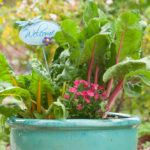
Swiss chard can be grown from seed or transplants and does well in a container or in the ground.
There may still be a few scorchers ahead but at some point this month we’ll see a slight shift in the weather as nighttime temperatures g-r-a-d-u-a-l-l-y start to cool off making it more feasible to plant seeds and transplants, especially if you provide some type of shade cover for new plantings. The average first frost in Central Texas can be expected around the first week of December which gives us approximately three months of good growing weather for cold sensitive plants such as green beans, cucumbers and squash. Plant seeds of these vegetables as soon as you can and choose quick-growing varieties that produce in 50-60 days.
Plants that prefer cool weather, including broccoli, cabbage, kale, beets, carrots, radishes and peas can be planted later in the month. They are very hardy once established in the garden and can withstand light freezes. Even if you don’t have the space for an in-ground garden many fall vegetables and herbs are well suited for growing in containers that can be placed in a sunny location near the house for easy access.
September Vegetable Garden Checklist
Here is the vegetable gardener’s checklist for September (for more gardening chores, see the Monthly Gardening Calendar.)
What to Plant
- Always plant seeds and transplants into moist soil for improved germination and establishment.
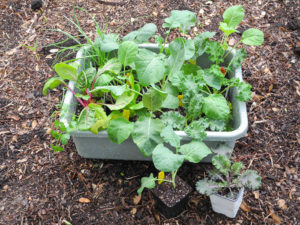
Give transplants a good soaking before planting in the ground.
- Gradually expose vegetable transplants to outdoor conditions before moving them to the garden, especially if they have been grown in a cool indoor environment.
- Plant bush beans, summer squash or cucumbers; seeds of these quick-growing crops will germinate in less than a week and most varieties start producing in less than 60 days.
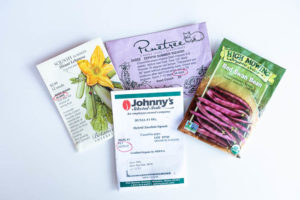
When growing beans, cucumbers or squash in the fall choose varieties that have the shortest ‘Days to Harvest’ to ensure production before cold weather arrives.
Check the seed packet and choose varieties that have the shortest ‘Days to Harvest’ to ensure production before cold weather arrives.
- Transplants of broccoli, cauliflower, cabbage, kale, arugula, kohlrabi, Swiss chard and Asian greens can be planted this month. Pay attention to the weather forecast and try to plant when we have a slight break from the hottest temperatures. Provide shade for new plantings during the first couple of weeks to make the transition easier.
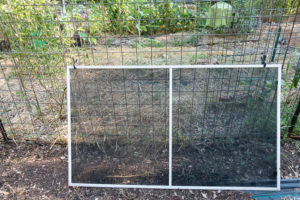
Shade helps plants transition to their outdoor environment. Use shade cloth, old window screens, bed sheets or burlap to fashion a temporary shade covering for new transplants.
-
- Plant seeds of sugar snap, snow peas and/or English peas during the latter part of the month. They will start producing in about 2 months, just in time for Thanksgiving, and hopefully will keep producing right up until Christmas.
- Root crops – carrots, beets, radishes and turnips – can be planted from seed this month. Plant a small section every 10-14 days to ensure a continuous harvest.
- Wait to plant lettuce and spinach – they grow best in cooler weather. Start seeds in small pots now for transplanting to the garden next month.
- Fall herbs that can be planted this month include cilantro, dill, fennel, oregano and mint. Transplants should start showing up in nurseries soon.
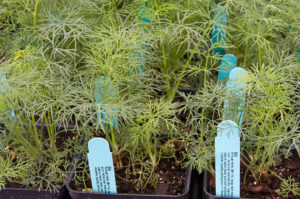
Cool season herbs that can be planted this month include dill, cilantro, oregano, fennel, thyme and sage.
- Add some colorful blooms to the vegetable garden with plantings of alyssum, calendula, petunias, snapdragon and nasturtiums.
When to Fertilize
- Feed vegetables with a water-soluble fertilizer every 2-3 weeks for fast and vigorous growth.
Other Maintenance
- Remove plants that are past their prime or no longer producing. Revive the soil with a layer of compost and mulch before the next round of planting.
- Prepare one or more compost bins to collect leaves, grass, kitchen waste and landscape trimmings.
- Don’t be intimidated by forecasts of 100° days; remember that is only the high and it takes all day to get there. If your schedule allows (and your yard is not infested with mosquitoes) early morning is the best time for fall gardening!
- Order garlic for planting in October. Many online sources sell out quickly so order early for the best selection.
- Mulch planting areas to conserve moisture, moderate soil temperature and limit weed growth.
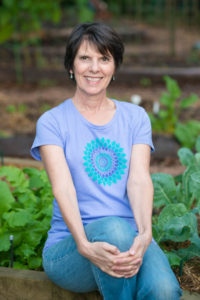 Patty G. Leander is a contributing editor for Texas Gardener magazine and an active member of the Travis County Master Gardener Association with an Advanced Master Gardener specialty in vegetables. She has been growing vegetables year-round in her Austin garden for over 20 years, encouraging the use of sound, horticultural principles that will lead to a bountiful harvest.
Patty G. Leander is a contributing editor for Texas Gardener magazine and an active member of the Travis County Master Gardener Association with an Advanced Master Gardener specialty in vegetables. She has been growing vegetables year-round in her Austin garden for over 20 years, encouraging the use of sound, horticultural principles that will lead to a bountiful harvest.
